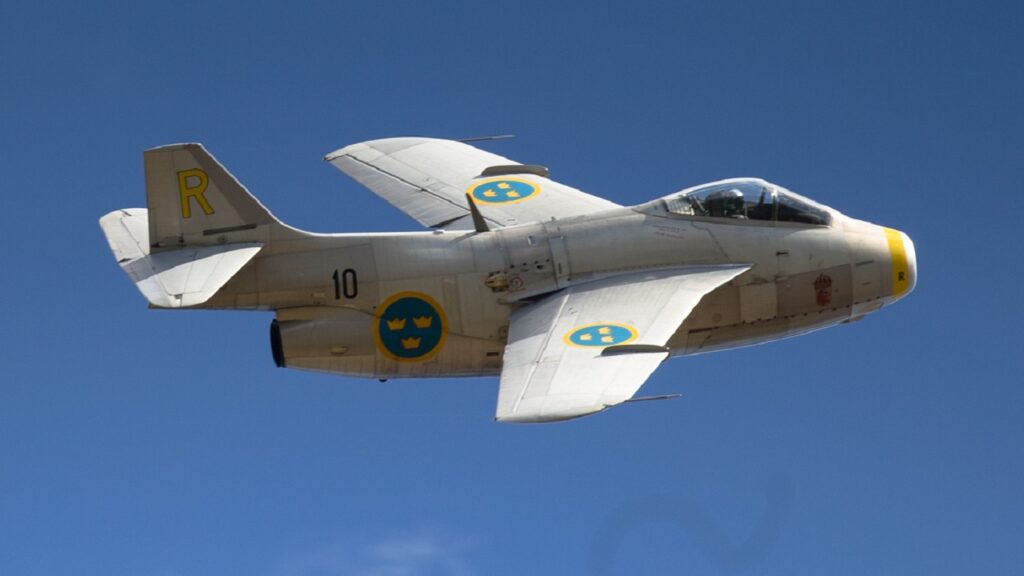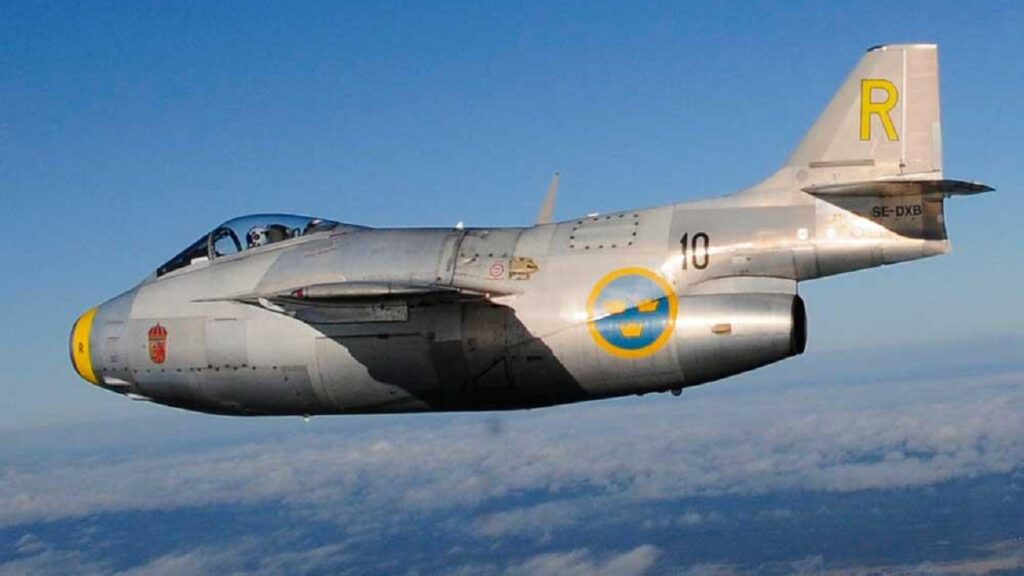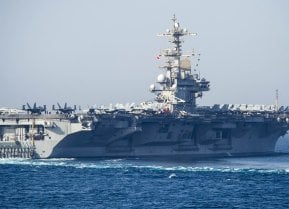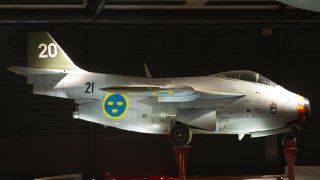The Saab 29 Tunnan Is a Fighter Jet Work Of Art
Even today, the Saab 29 Tunnan is an aircraft distinctive of its time. The Tunnan features a swept wing, making it the first fighter in Western Europe to be produced with a swept wing following the Second World War.
Meet the Saab 29 Tunnan: In America, when most people think about Saab the first thing they think about is automobiles. Distinctive, hatchbacks. Sporty sedans. Ignition blocks in the center console. The Saab, no longer available in the North American market, has generated something of a cult following.
Saabs are still a hot ticket on the used market, on places like Craigslist – and Nordic-specific dealers. I learned to drive on a 9-5 wagon, and I still take a second look every time I see a Saab drive by.
But many Americans may not be aware, despite Saab advertising the fact, that Saab built fighter jets long before it introduced 9-series automobiles to the American market. Really, Saab is more “about” jets than about cars. In fact, the Swedish Air Force has been dependent on Saab products for nearly one hundred years.
Currently, the lynchpin of Saab’s aviation lineup is the JAS 39 Gripen. But the Gripen is just the latest in a long line of relatively successful products – which includes Saab’s second-ever jet aircraft, the Saab 29 Tunnan.
The History of Saab Aircraft
Saab began making aircraft in the 1930s. Notably, Saab produced the Saab 17 dive bomber during World War II. The effort was followed with Saab’s first fighter, the Saab 21, a distinctive twin-boom push-prop monoplane built in the late 1940s. Saab first ventured into jet-powered aircraft with the Saab 21R, a variant of the Saab 21 outfitted with a jet-engine. But only 64 Saab 21Rs were built. Saab’s first large-scale effort into jet-powered aircraft was the Saab 29 Tunnan, of which 661 were built, between 1950 and 1956.
Even today, the Saab 29 Tunnan is an aircraft distinctive of its time. The Tunnan features a swept wing, making it the first fighter in Western Europe to be produced with a swept wing following the Second World War. The Luftwaffe’s Messerschmitt Me 262, which happened to be the world’s first-ever jet-powered aircraft, previously featured a swept wing design.
The Tunnan also featured a barrel-like fuselage, which gave the jet a somewhat rotund appearance. Actually, the Tunnan earned the nickname Flygande Tunnan, or “The Flying Barrel,” part of which eventually became the official designation. When I look at the Tunnan, I think of both the Soviet MiG 15 and the American F-86 Sabre, two jets that met regularly over the skies of the Korean Peninsula, at the same time the Tunnan was being produced.

The Beginning of the Saab 29 Tunnan
The Tunnan began as the R 1001 Concept. Initially, the project incorporated a straight wing – but after Swedish engineers obtained German swept wing research data, via Switzerland, where some Messerschmitt engineers had escaped, the jet was reshaped with a 25-degree wing sweep. The logic behind the change, was the understanding that swept-wing designs reduced drag significantly, especially as the aircraft approached the sound barrier.
In addition to the swept wing, the wings were designed to be as thin as possible. To craft the wing so thinly, the undercarriage was designed to retract into the fuselage rather than into the wings like so many other jets. The wings also included leading edge slots, interconnected with the flaps, to provide the lateral stability needed during take-off and landing.
Initially, the Saab 29 Tunnan was designed around a de Havilland Goblin turbojet, yet the Goblin was abandoned in favor of the more powerful de Haviland Ghost. The Ghost was better suited for the Tunnan because the Ghost was arranged for a circular air intake and its diameter would fit within the Tunnan’s barrel-shaped fuselage. The Ghost was capable of providing 5,000 pounds of thrust, and would later be proven to take the Tunnan to speeds as high as 650 miles per hour.

The Saab 29 Tunnan Takes Flight
The Tunnan’s first-ever flight was on September 1, 1948. Bob Moore, who later became the first managing director of Saab GB UK, made the first flight. Afterward, Moore said that the Tunnan was an “ugly duckling” on the ground – but “swift” in flight.
Four Tunnan prototypes were built for testing. The first two were built without armament. The third, however, was outfitted with four 20mm cannons.
The tests went well; the Tunnan was found to be faster than expected and the jet was put into production. The final product entered the Swedish Air Force in 1950. Notably, the Tunnan would be used to break speed records in the 1950s. In 1954, the Tunnan set a record on a 500km closed circuit. And again, in 1955, the Tunnan set an international speed record on a 1,000 km closed-circuit course.
The Tunnan served successfully in the Swedish Air Force, the Austrian Air Force, and the United Nations. But the Tunnan has been retired since 1974 and today, only a few surviving models exist in a few museums throughout Europe.
Harrison Kass is a prolific defense and national security writer with over 1,000 published articles. An attorney, pilot, guitarist, and minor pro hockey player, Harrison joined the US Air Force as a Pilot Trainee but was medically discharged. Harrison holds a BA from Lake Forest College, a JD from the University of Oregon, and an MA from New York University. Harrison listens to Dokken.
All images are Creative Commons.


